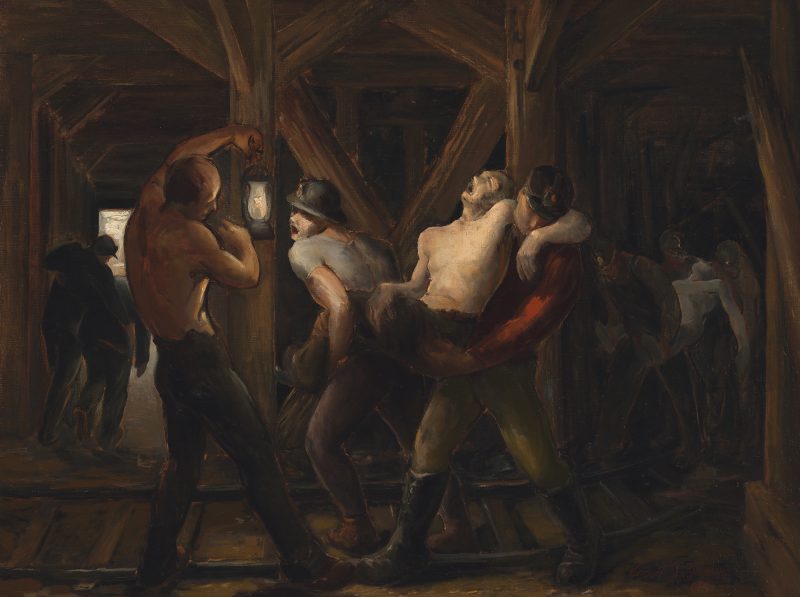
Coal Mine Disaster
La Gambina, Vincent
1941
Artwork Information
-
Title:
Coal Mine Disaster
-
Artist:
La Gambina, Vincent
-
Artist Bio:
American, 1909–1994
-
Date:
1941
-
Medium:
Oil on canvas
-
Dimensions:
30 1/8 x 40 1/8 inches
-
Credit Line:
Wichita Art Museum, Gift of the artist
-
Object Number:
1988.18
-
Display:
Currently on Display
About the Artwork
In La Gambina’s Coal Mine Disaster, the horror of a contemporary catastrophe is ennobled by the visual language of the Old Masters. Against the backdrop of timbers in the gloom, three groups of miners struggle towards safety. Coal car tracks, curving forward from background to foreground and returning to the distance, link the groups and underscore their movement from right to left, from the darkness of the mine’s depths to the light of its entrance.
On the right, only barely discernible in the deep shadow of the shaft, three miners carry the motionless body of a man whose ashen color and lolling head imply that he is dead. On the left, a miner aids a limping comrade who has recovered enough to move, under his own power, towards the brightness of the entrance. The central group, then, suspended in a pool of light in the darkness, teeters between life and death. Two men carry the injured miner, one staggering under the weight of the victim’s bare torso and the other grasping his legs; a third man turns back to the group and raises the lamp that illuminates the scene. The wounded man’s eyes are closed and his mouth gapes as if gasping for breath, while the mouth of the left rescuer is also open, as if shouting in fear. Neither gone from life nor safely in the world, the central figure and his rescuers are frozen at a decisive moment in time.
The dramatically rendered central group of Coal Mine Disaster can be compared with scenes of the burial of Christ from earlier art historical periods; Raphael’s Entombment of Christ, for example, although not compositionally identical, is similar enough to have served as a prototype for La Gambina’s painting.1 The American artist’s interpretation of the subject in the style of the Old Masters was undoubtedly the result of his academic training at the Leonardo Da Vinci School of Art and the National Academy of Design, and perhaps even owes something to his Italian heritage.
In this modern history painting, La Gambina depicts a very timely subject. In 1941, the year of Coal Mine Disaster, widespread strikes by the United Mine Workers Association resulted in some instances of violence and even murder. The seemingly endless negotiations between miners and mine owners were chronicled in the New York Times on a daily basis throughout 1941, indicating the country’s concern about its industrial stability as the threat of war loomed. La Gambina’s opinion about these events is not known, but as an artist who had worked under the WPA and amidst the leftist atmosphere of the Artists Union, it is possible that his painting indicates his political support for the worker. Without doubt, however, his work sympathetically captures the pathos of the disaster and the heroism of those engaged in the rescue.
1. The Raphael is reproduced in Leopold D. and Helen S. Ecrlinger, Raphael (Oxford: Phaidon, 1987), 69.